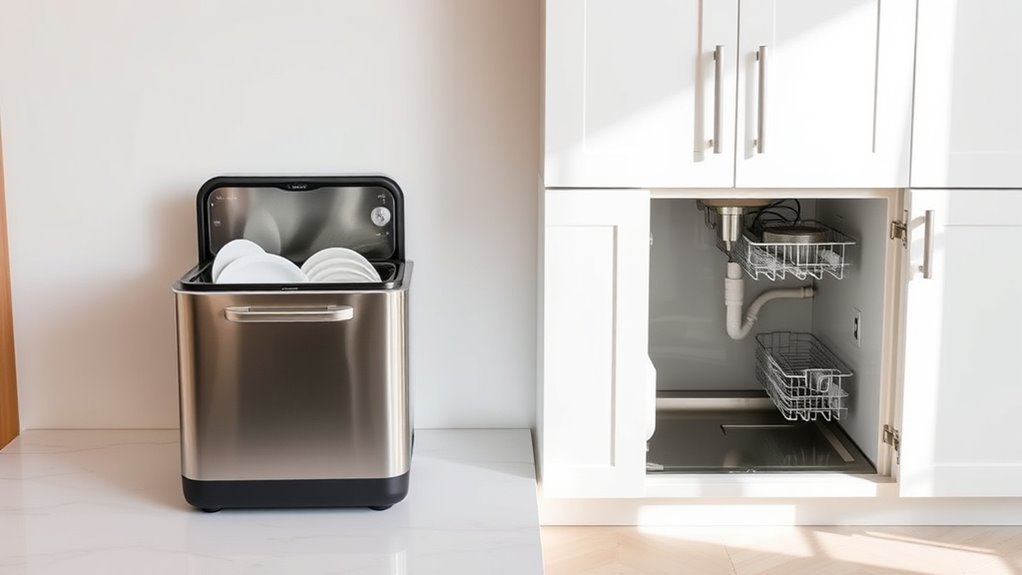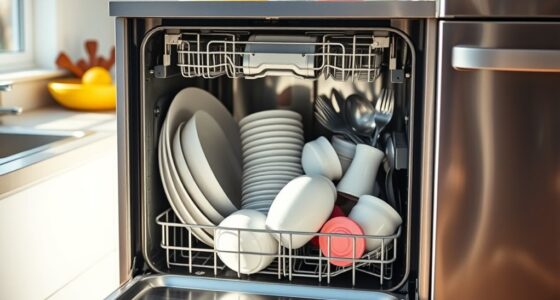If you want flexibility and easy installation, a countertop dishwasher works great for your apartment since you can place it anywhere and set it up quickly. Under-sink models save space and look sleek, but they’re fixed once installed and cost more upfront. Consider how much capacity you need, your budget, and whether you prefer portability or integrated style. Exploring these options more will help you choose the best fit for your space and lifestyle.
Key Takeaways
- Countertop dishwashers are portable and flexible, ideal for renters and small apartments with limited space.
- Under-sink models offer a sleek, integrated look but are fixed and less adaptable to layout changes.
- Countertop units are easier and quicker to install, suitable for temporary setups or quick relocations.
- Under-sink dishwashers generally provide larger capacity and may be more energy-efficient long-term.
- For space-saving and flexibility, countertops are better; for built-in aesthetics and capacity, under-sink models excel.
Space and Placement Considerations

When choosing between a countertop and an under-sink dishwasher, considering space and placement is vital. Countertop dishwashers are compact, making them ideal if you have limited kitchen space. Their durability allows them to withstand frequent movement, but they require a sturdy surface to sit on. If you prefer easy access, a countertop model offers quick under-sink accessibility, letting you load and unload efficiently. Under-sink dishwashers fit neatly beneath your kitchen counter, saving valuable space. However, their installation depends on available under-sink clearance and plumbing connections. While they integrate seamlessly into your cabinetry, their placement might limit accessibility if the area is cramped. Always assess your kitchen layout to determine which option optimizes space and ensures convenient placement for daily use. Additionally, evaluating your space management can help optimize your kitchen layout for better functionality and ease of access.
Installation Process and Ease of Setup
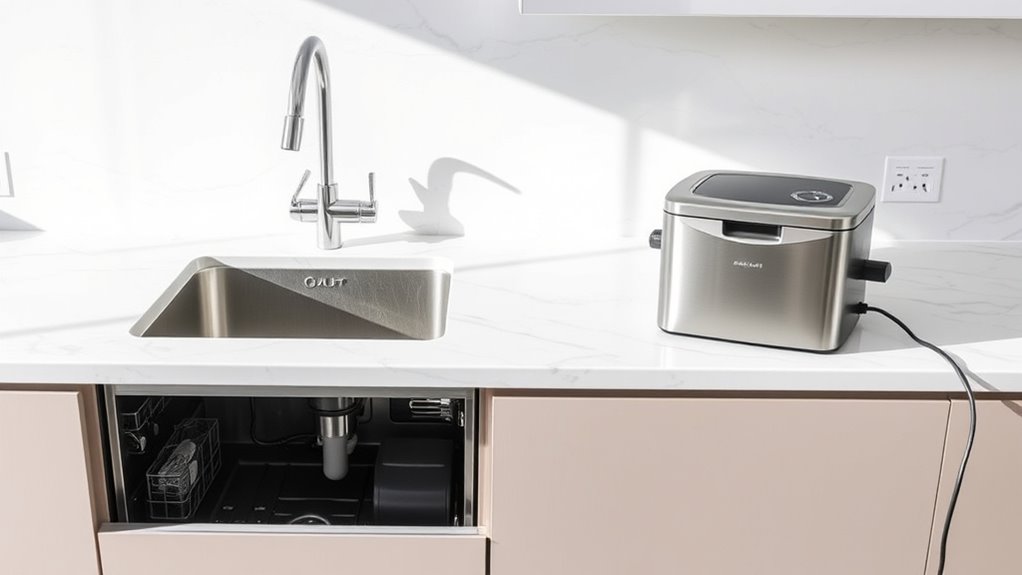
Installing a countertop or under-sink dishwasher can vary in complexity, but generally, countertop models are straightforward and quick to set up. With minimal installation complexity, you usually just place the unit on your countertop, connect the water supply, and plug it in. Setup time is short, often taking less than 30 minutes, making it ideal for renters or those needing a quick solution. Under-sink dishwashers often require more effort, as you’ll need to connect to existing plumbing and secure the unit properly, increasing setup time and complexity. While under-sink models may involve some tools and basic plumbing skills, they typically take longer to install than countertop units. Overall, countertop dishwashers offer a hassle-free, speedy setup, perfect for quick installation needs. Additionally, considering the installation process can help determine which model best fits your space and technical comfort level.
Capacity and Washing Performance
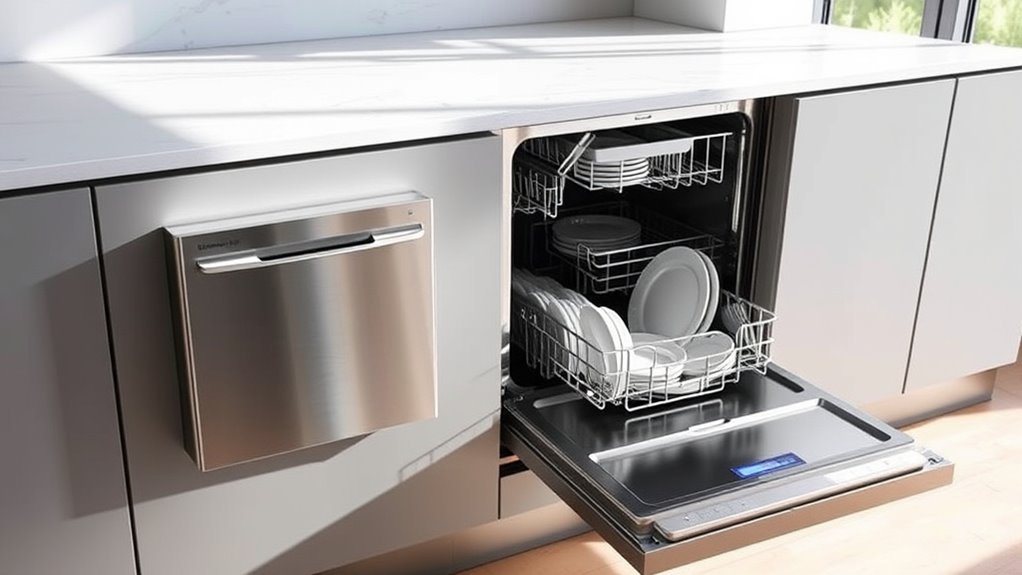
Countertop dishwashers typically have smaller capacities, making them suitable for individuals or small households with fewer dishes to clean at once. While they efficiently handle everyday loads, their limited space means you might need to run multiple cycles for larger families. When considering design aesthetics, countertop units are compact and easily blend into modern kitchens, though their size can affect loading flexibility. Noise levels vary by model, with newer designs often featuring quieter operation, so you won’t be disturbed during your daily routines. Overall, if you prioritize convenience and space-saving design, a countertop dishwasher offers satisfactory capacity and performance for small-scale cleaning needs. Additionally, installation options are usually straightforward, making them a popular choice for renters and those seeking minimal setup.
Energy Efficiency and Water Usage
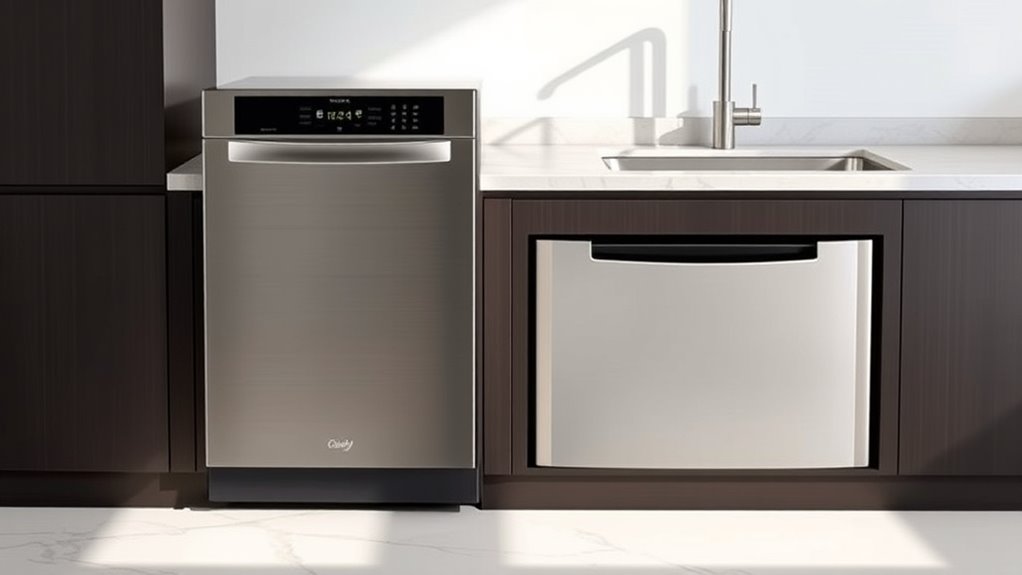
Both countertop and under-sink dishwashers can help you save water compared to hand washing, but their efficiency varies. You’ll also want to contemplate how much energy each model consumes during operation. Understanding these differences can help you choose the most eco-friendly option for your home. Additionally, considering the resources and tools available for evaluating energy and water consumption can further inform your decision.
Water Conservation Benefits
Are you wondering which dishwasher type saves more water and energy? Both countertop and under-sink models promote water conservation with efficient dishwasher cycles and water recycling features. Countertop dishwashers typically use less water per cycle, making them ideal for small loads. Under-sink units often incorporate water recycling, reusing rinse water to cut down on overall usage. Here’s a quick comparison:
| Feature | Countertop Dishwasher | Under-Sink Dishwasher |
|---|---|---|
| Water Usage per Cycle | Lower | Slightly higher |
| Water Recycling | Limited | Advanced water recycling |
Choosing the right model depends on your habits, but both help reduce water waste by optimizing cycles and recycling water wherever possible. Additionally, selecting sulfate-free options can further help maintain appliance efficiency and protect your plumbing.
Energy Consumption Differences
When it comes to choosing between countertop and under-sink dishwashers, understanding their energy efficiency and water usage is key. Countertop models generally use less power per cycle, offering noticeable energy savings, especially if you run dishes frequently. They typically have smaller capacities, which means they consume less water and energy per load. Under-sink dishwashers tend to have larger capacities, but they often have higher power consumption, which can increase your energy bills. However, they may be more efficient overall if you do larger loads regularly. To maximize energy savings, look for models with energy-efficient ratings and eco-friendly features. Additionally, considering the size and capacity of the dishwasher helps ensure it meets your household’s needs without unnecessary energy waste. Balancing power consumption with your household’s dishwashing needs helps you choose the most energy-efficient option for your apartment.
Portability and Flexibility

Portability and flexibility are key factors when choosing a dishwasher. You’ll find that countertop models are easy to move and fit into small spaces, making them ideal for tight kitchens. Under-sink dishwashers, on the other hand, offer better space optimization and can be placed more flexibly within your setup. Additionally, consider how rebuilding trust and demonstrating reliability can influence your decision, especially if you plan to relocate or need a solution that adapts to changing circumstances.
Easy to Move
Countertop dishwashers excel in portability because they’re lightweight and compact, allowing you to move them easily from one spot to another. Their portable design makes them ideal for renters or anyone needing flexibility. When considering weight considerations, these units are typically easy to handle without requiring heavy lifting. You can:
- Carry them with one hand thanks to their lightweight build
- Place them on countertops or tables temporarily
- Relocate for cleaning or storage without hassle
Their small size means you won’t need to worry about fitting them through doorways or up stairs. This ease of movement ensures you can quickly adapt your kitchen setup based on your daily needs or space constraints, making them a practical choice for dynamic living environments.
Space Optimization
Because of their compact size and lightweight design, countertop dishwashers offer exceptional flexibility in optimizing your kitchen space. Their small, countertop style footprint allows you to place them almost anywhere, making them ideal for limited areas. You can easily move them aside when not in use or relocate them to different spots as needed. This portability helps maximize your available space without permanent installation. In contrast, under sink designs are built to fit beneath your existing cabinetry, saving counter space but reducing mobility. While under sink models utilize space efficiently and keep your kitchen tidy, countertop dishwashers give you the freedom to adapt your setup quickly. If space flexibility is a priority, countertop style units provide a clear advantage for apartment living. Additionally, automation technologies in appliances are advancing rapidly, enabling smarter and more versatile options for small spaces.
Flexibility in Placement
While under-sink dishwashers are designed to fit neatly beneath your cabinetry, they offer limited flexibility once installed. You can’t easily move them around or change their location, which impacts your design aesthetics and convenience. In contrast, countertop dishwashers are portable, allowing you to place them wherever you see fit—closet, countertop, or different rooms. This flexibility means you can adapt to your apartment’s layout and changing needs. Additionally, countertop units tend to operate more quietly, reducing noise levels that might disturb your daily routine. Keep in mind:
- You can relocate a countertop dishwasher easily for cleaning or reorganization
- Under-sink models are fixed, limiting placement options
- Portability enhances adaptability to your apartment’s layout and aesthetic preferences
- The compact size of countertop models makes them ideal for small spaces and makes storage easier when not in use
Cost and Value for Money
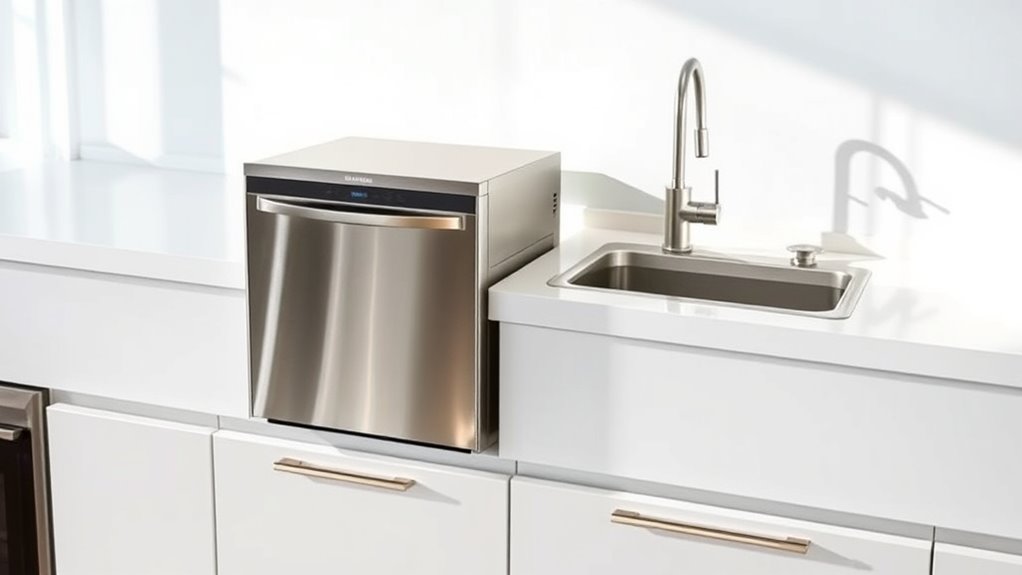
When evaluating the cost and value for money, it’s important to contemplate both the upfront expense and long-term savings of each dishwasher type. Countertop dishwashers generally cost less initially but may use more water and energy over time. Under-sink models tend to be pricier upfront but often offer better efficiency and capacity, which can save you money long-term. To help you decide, consider this comparison:
| Feature | Countertop | Under-Sink | Brand Comparison & Aesthetic Appeal |
|---|---|---|---|
| Initial Cost | Lower | Higher | Varied by brand, sleek designs |
| Operating Costs | Moderate | Lower | More energy-efficient models |
| Aesthetic Appeal | Compact, basic | Integrated, stylish | More seamless, modern look |
| Longevity | Shorter | Longer | Quality brands enhance value |
Additionally, choosing a permanent installation can contribute to greater durability and long-term savings.
Maintenance and Durability
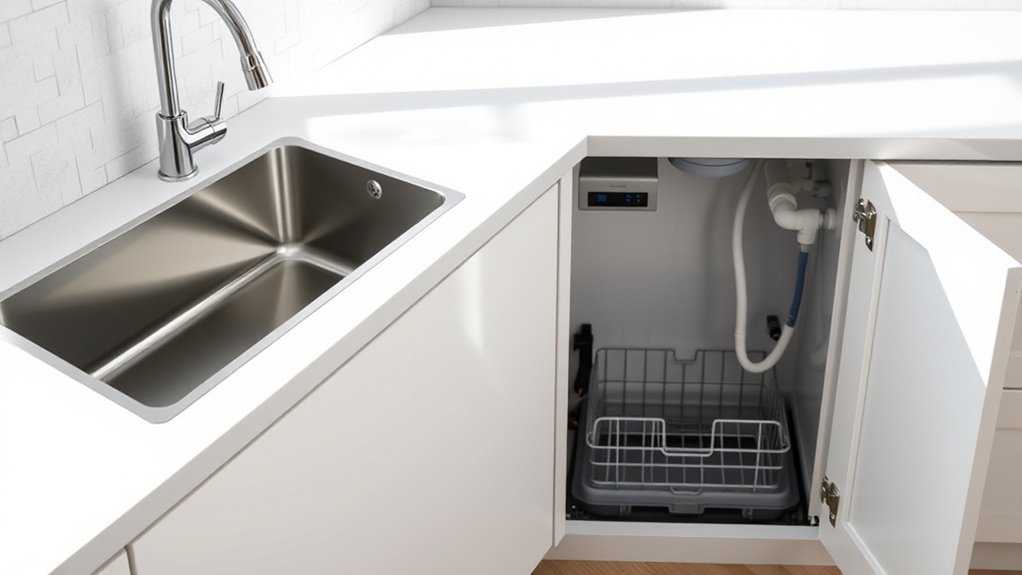
Maintenance and durability are critical factors to contemplate when choosing between countertop and under-sink dishwashers. You’ll want a unit that lasts and stays efficient over time. Countertop models typically have simpler designs, making cleaning cycles easier to manage, but may wear out faster with frequent use. Under-sink dishwashers are built for durability, often featuring higher-quality parts, but might produce more noise during operation. To keep your dishwasher in top shape, consider these points:
Prioritize durability and easy maintenance for long-lasting dishwasher performance.
- Regularly clean filters and spray arms to ensure ideal cleaning cycles
- Check seals and gaskets to prevent leaks and prolong lifespan
- Monitor noise levels, especially if your apartment has thin walls or shared spaces
- Understanding the role of guidance and support in maintaining appliances can help you troubleshoot issues before they become costly. Choosing a model that balances effective cleaning and low noise can save you maintenance headaches and extend its longevity.
Frequently Asked Questions
Can Countertop or Under-Sink Dishwashers Handle Large Loads Effectively?
You might wonder if countertop or under-sink dishwashers can handle large loads effectively. Generally, under-sink models have a bigger loading capacity, making them better for larger family dishes or frequent use. Countertop dishwashers are more compact, so they’re ideal for small loads and quick cleaning. Both types can be energy-efficient, but under-sink models often use less water and power per load, enhancing overall energy efficiency.
Are There Specific Plumbing Requirements for Installing Under-Sink Dishwashers?
When considering under-sink dishwashers, you should check plumbing compatibility and installation complexity. Many models require a dedicated water supply line and proper drainage, so verify your plumbing can handle these connections. If your existing setup isn’t compatible, installation might get tricky, possibly needing professional help. Confirm before buying to avoid surprises, and remember that a straightforward setup can save you time and money.
How Long Does Each Type Typically Last With Regular Use?
You’ll find that countertop dishwashers generally last around 3-5 years, with less maintenance needed but more frequent replacement, while under-sink models may last 7-12 years due to their durability differences. Under-sink units require regular maintenance to prevent issues, but their sturdier build often means they stay functional longer. Your choice depends on how much upkeep you’re willing to do and the longevity you expect from your dishwasher.
Do Countertop Dishwashers Require Special Cleaning or Maintenance?
Countertop dishwashers do require some cleaning routines and maintenance tips to keep them working efficiently. You should regularly clean the filter, run empty cycles with vinegar to remove buildup, and wipe down the exterior. Keep the water inlet and drain clear, and check for any leaks. Following these maintenance tips helps extend their lifespan and guarantees your dishes come out sparkling every time.
Which Option Is More Suitable for Small Apartments With Limited Space?
They say “less is more,” and in small apartments, space is precious. An under-sink dishwasher offers sleek aesthetic integration, freeing up counter space, while a portable countertop model provides flexible convenience that you can tuck away when not in use. Both suit limited space, but if you prioritize a tidy look, an under-sink option is ideal. For quick, movable convenience, go with a countertop model.
Conclusion
So, whether you choose a countertop or under-sink dishwasher, remember: it’s all about fitting your lifestyle — or fitting into your tiny apartment. Sure, one may save space, but the other might save your sanity with easier setup. Whichever you pick, just don’t forget to wash dishes yourself once in a while; after all, no gadget can replace good old-fashioned elbow grease. Happy dishwashing — or not!
